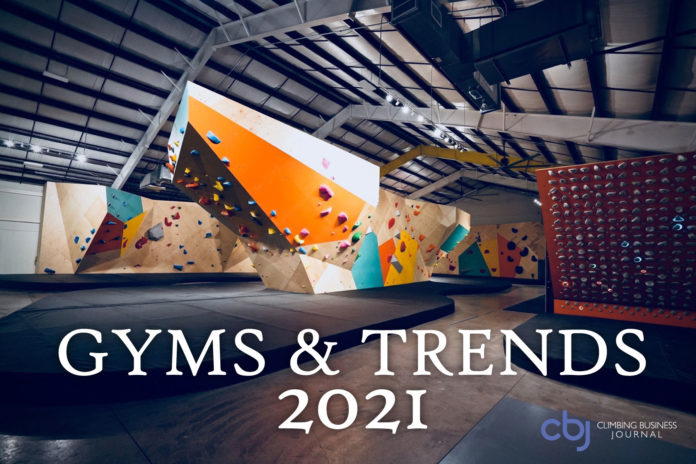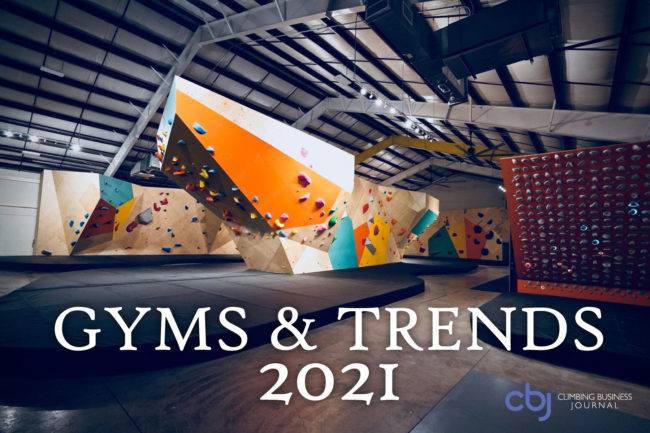
Upon reflection, it’s clear that two of the most significant and prominent forces impacting the climbing industry this past year were the sport’s debut at the Tokyo Olympics and the ongoing COVID-19 pandemic. Much like it had in 2020, the pandemic continued to impact nearly every aspect of climbing gym operations in 2021—from supplies to member attendance and, in some cases, ongoing temporary closures. And the Olympics, which had long sat on the horizon as one of the most highly anticipated climbing events of all time, finally became a reality (in August) and Nathaniel Coleman became America’s first climbing Olympian to bring home a medal. Of course, the Olympics and the pandemic were always significantly intertwined, even inseparable at times, with the postponed eventuality of the Olympics taking place without in-person fans and with myriad COVID mitigation measures for the athletes.
Most interesting for the purposes of this report is that it is still too early to gauge the long-lasting effects on the climbing gym industry of both the Olympics and COVID-19. But wrapped in both is the fact that 2021 saw the most new U.S. climbing gym openings ever(!), resulting in the total number of commercial facilities in the United States and Canada edging over 700. If future projections prove true, the number of climbing gyms in the U.S., alone, will surpass 600 by the end of 2022.
Of course, gym development is one thing, but the growth of any customer base is another. And it’s no secret that a big hope among new and longtime climbing gym owners alike was that the Olympics, in particular, would prompt an influx of new customers. To that point, El Cap, the parent company of the Movement gyms, did issue a press release in August related to an uptick in gym visits at the time of the Olympics. AP News and Forbes also covered gym climbing’s increased popularity in the Olympic age.
“Across the country, our locations saw an increase in gym visits—in July, specifically, we saw a 10% increase alone in day passes sold,” Movement’s Chief Marketing Officer, Charlotte Bosley, told CBJ. “The week sport climbing was featured at the Olympic Games our website traffic grew by 45% compared to the week prior. We also saw an increase in new climbers gearing up with climbing shoes and harnesses.”
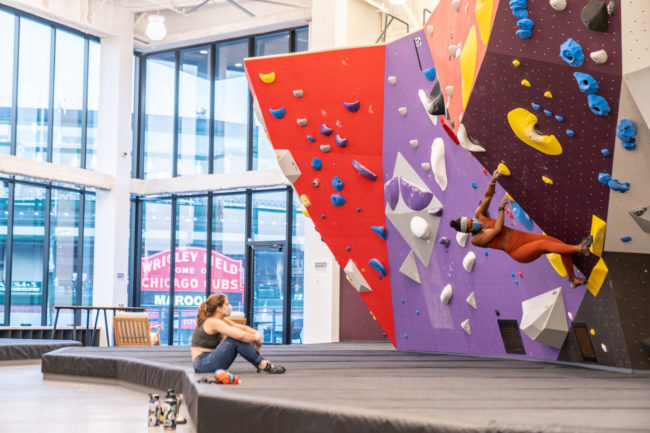
But it seems that such an Olympic-prompted surge in climbing interest was difficult to gauge at other facilities. For example, the owner of Ascent Studio in Colorado, Jon Lachelt, said it was hard to tell whether the Olympics “affected” his climbing gym, noting “it’s difficult to tease apart the contrasting effects of COVID vs. the Olympics.” Still, Lachelt shared with CBJ that Ascent Studio’s youth program revenue for 2021 matched that of 2019—despite some capacity restrictions during the year.
Additionally, most of the new climbing gyms that officially opened in 2021 in the U.S. were in development prior to the onset of the pandemic, so any significant stress from the pandemic broadly on gym growth will likely be better gauged over the next few years. Yet, through it all, the climbing gym industry continues to weather the pandemic storm better than more general fitness industries. “The industry’s resilience in the face of the COVID-19 pandemic is remarkable,” said Dustin Buckthal, CEO/CFO of Vertical Solutions and The Front Climbing Club, citing a report by Morgan Stanley. “In general, the climbing industry braved the storm far better than the general fitness industry, with only three percent of climbing gyms having closed in 2020, compared with 20-25% of general fitness locations.”
At the time of this writing, climbing gyms throughout North America continue to be altered in unprecedented ways by the pandemic (and the Omicron variant, specifically). This makes it very difficult to attach effects and ramifications to the isolated year of 2021. Perhaps COVID’s most important impact on the climbing industry, particularly in 2021, came in the form of supply chain and labor market challenges, which were felt throughout the wider economy—explored in greater detail below. But let’s focus first on the positives, and dive into all of those new climbing gym openings of 2021. (In tandem with this report, please visit CBJ’s 2021 Gym List Awards for a full list of these new gyms.)
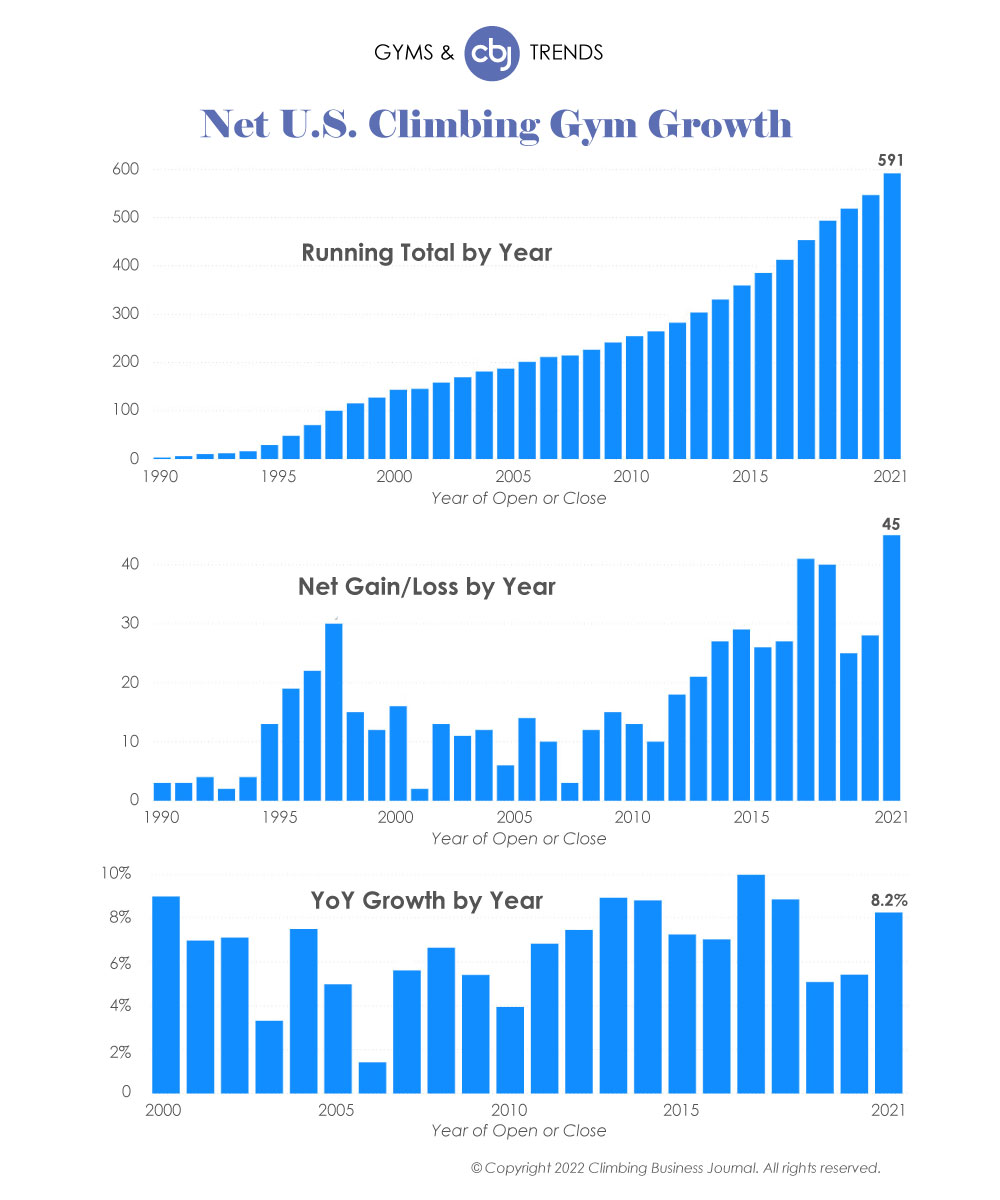
53 new climbing gyms opened in the U.S. in 2021
By the numbers, 2021 saw 53 new climbing gyms open in the U.S., which amounted to the most new openings in the country for a single calendar year. Perhaps most remarkably, 2021 also saw the most net gym openings in the history of the American climbing gym industry (45). That net number indicates that there were surprisingly few permanent facility closures in 2021—8, in total—despite the pandemic’s ongoing effects on the industry and gyms’ road to recovery.
As a matter of fact, 8 climbing gym closures is the first time that less than 10 gyms have closed in the U.S. industry since 2016, the year sport climbing was added to the Tokyo Olympics. Such relatively few permanent closures―the fewest in the past seven years―presented a welcome rebound after 20 climbing gyms permanently closed their doors in 2020 (due primarily to the impacts of the pandemic that was still fairly new at the time).
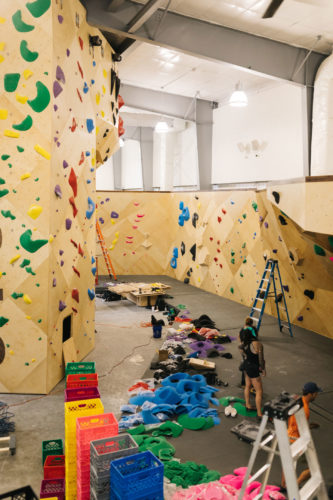
Taken together, the growth rate of U.S. climbing gyms in 2021 (8.24%) was higher than the growth rate for the two preceding years (5.41% in 2020, 5.07% in 2019) and continues the trend of robust climbing gym growth which has surpassed 5% every year for the past eleven years.
Buckthal told CBJ that the opening of so many new climbing gyms in 2021 was in part a result of crowding (and, at peak times, overcrowding) at existing climbing gyms. “Furthermore,” Buckthal added, “the demand for open, spacious areas, as found in climbing gyms, is accelerating due to both the federal and local demand for decreased gym crowding and increased capacity restrictions.”
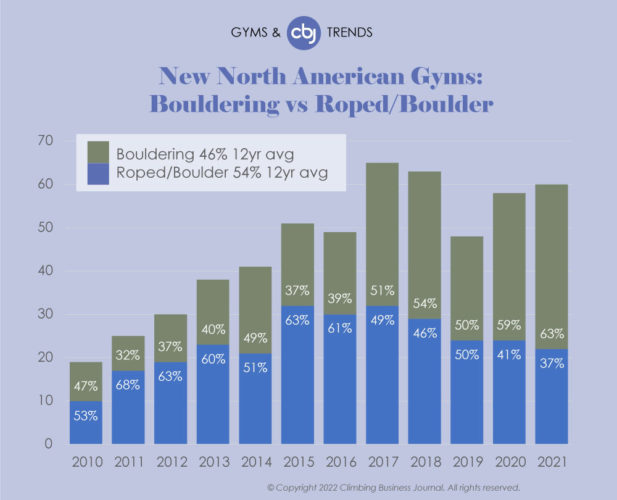
63 percent of new North America climbing gyms in 2021 were bouldering gyms
The development of bouldering-focused climbing gyms in North America has been trending upward for more than a decade. But in 2021 both the number of new U.S. bouldering gyms and ratio of new U.S. bouldering to mixed gyms (gyms with roped climbing) reached all-time highs. Approximately 64% of the new climbing gyms in the U.S. last year―34 gyms in total―were exclusively bouldering facilities in terms of their climbing offerings (63% and 38 in North America). The percentages have often been even higher in Canada, where new bouldering gyms have outpaced mixed gyms every year for the past six years.
Bouldering gyms also represented few of the climbing gym closures in 2021. Of the 8 facilities in the U.S. which permanently closed their doors last year, only 3 were bouldering gyms―Deadpoint Bouldering and Fitness (NC), The Cave Climbing Gym – New Cumberland (PA) and Austin Rock Gym North (TX). Yet again, the addition of 31 net bouldering gyms in the U.S. marks an all-time high.
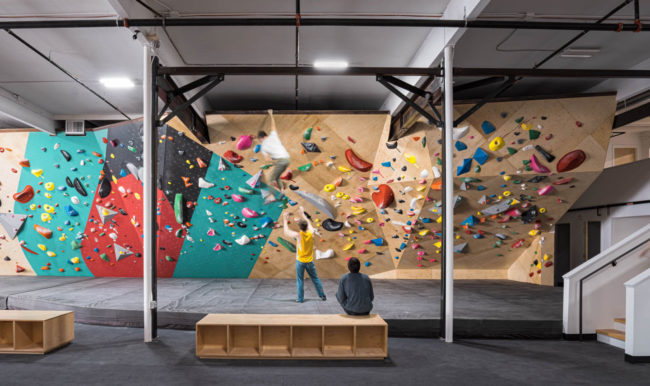
Such a significant number of new bouldering-focused facilities has long been attributed, in part, to reduced construction and operation costs. But the staff at Quebec-based wall manufacturer DÉLIRE explained that these advantages have become all the more important amid the uncertainties of the pandemic. “Bouldering gyms and standalone training facilities have less fixed costs,” DÉLIRE’s co-owner Jeff Beaulieu told CBJ. “So in the event of temporary closures or capacity restrictions, they have less fees to cover and can navigate these periods more easily than larger gyms.”
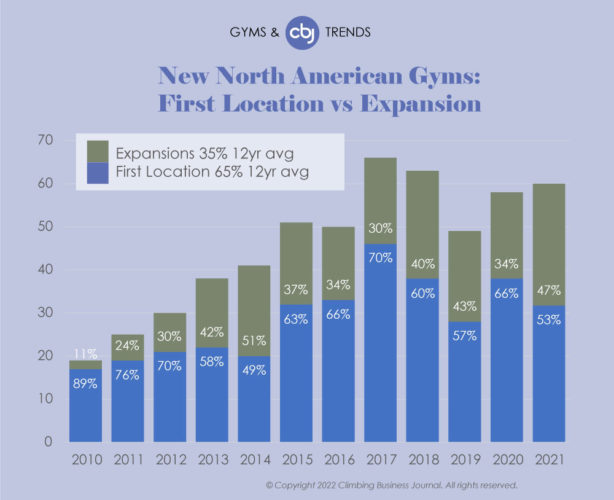
47 percent of new North America climbing gyms in 2021 were expansion gyms
In addition to the bouldering focus, another significant trend in 2021 was the expansion into new properties by preexisting gyms. Indeed, the percentage of new expansion gym openings in North America last year―as opposed to first location openings―was the greatest it’s been in seven years, since reaching an all-time high in 2014 (51%). About 47% of the new climbing gyms in 2021 were facilities opened by brands that have already operated at least one gym elsewhere. Such gyms included three new facilities from both Movement and Bouldering Project―which earned first place and second place, respectively, for the Top Developer of the Year award in CBJ’s 2021 Gym List Awards―as well as multiple developers gaining two new locations (The Gravity Vault, Sender One and Touchstone) and others growing through a mix of new gym openings and acquisitions (The Spot and VITAL).
Timy Fairfield, President of Futurist Consultants, pointed out the strengths of expansion gyms as climbing gym markets become increasingly competitive—and, in some cases, nearer to saturation. “As markets become more saturated with commercial climbing gyms,” Fairfield told CBJ, “[we may see] existing commercial gym chains having an inherent advantage over smaller newcomers, with more assets, financial history and operational experience to leverage.”
A sub-trend within the gym expansions for 2021 was a rise in the number of “training gyms,” meaning new facilities that are opened as exclusive spaces for certain members, youth teams, etc. There are a total of 10 such “climbing training gyms” currently in operation throughout North America, half of which opened in 2021 (by Beast Fingers, Reach, Sender One, Sportrock and Touchstone). Of these five training gyms, only Beast Fingers is not part of a gym chain.
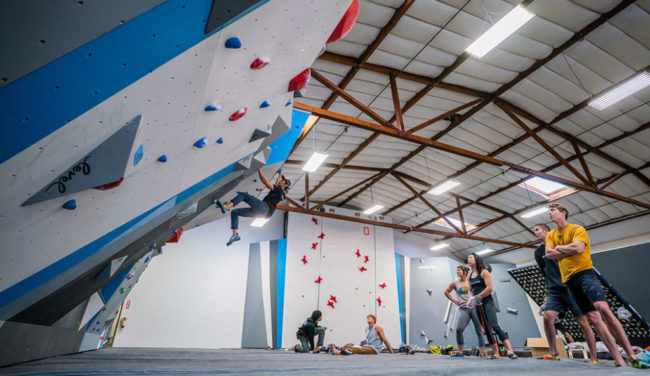
However, Fairfield pointed out that the advantages of these smaller, training and bouldering-specific facilities are not limited to expanding gym chains, and further expounded on some of the benefits for first-time climbing gym owners in particular. “[Bouldering/training gyms] require lower capital investment, they are faster to market, they have a lower cost of operation and there are more available, suitable commercial real estate locations to choose from,” explained Fairfield.
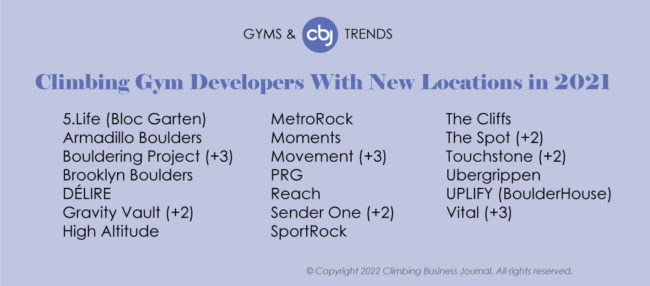
76 climbing gyms chains with 2 or more gyms exist in North America
Alongside the burgeoning of climbing gym chains via the creation of entirely new facilities, 2021 also saw two gym chains expand by acquiring existing locations. In the West, The Spot in Boulder and Denver, Colorado―the former of which was recognized when it first opened in 2002 as the first bouldering-focused gym in the U.S.―doubled its gym count with the acquisition of the two EVO gyms in Golden and Louisville. The Golden facility, in particular, was both acquired and opened in the same year. In the East, California-based VITAL―which opened its first NYC gym in Brooklyn earlier last year―continued its splash into the New York City market by acquiring the two Steep Rock Bouldering gyms in Manhattan.
Following last year’s developments, there are now 64 climbing gym chains in the U.S. with two or more facilities (76 in North America), and five gym chains with over 10 locations: El Cap – Movement (19), Central Rock (15), Touchstone (14), The Gravity Vault (12) and Hangar 18 (11). This year, El Cap – Movement―which recently rebranded all its Planet Granite, Earth Treks and Movement locations as Movement Climbing, Yoga, & Fitness―could become the first gym chain on the continent to operate 20 climbing gyms once Movement Design District finishes completion in Dallas, Texas.
The trend of acquisitions, mergers and private investing in the industry has been observed in CBJ’s Gyms & Trends throughout the years and was not limited to climbing gyms in 2021. The Kansas City-based gym management tech company Approach, for instance, announced plans for national and international expansion of its software after receiving $1.5 million in seed funding from Crux Collective. And Aragon, one of the largest climbing hold manufacturers in the world, was purchased by Tennessee-based PlayCore after having been owned for years by The Hanson Group.
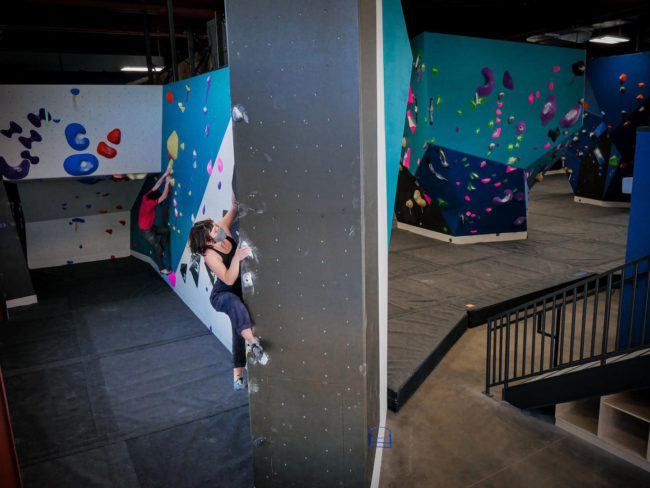
According to industry experts, such business developments are expected to continue as the industry progresses through the growth and shakeout stages of its life cycle. “The past couple years have shown us what I think is the first big phase of consolidation of the climbing gym world,” said Chris Danielson, owner of Thread Consulting. “There have been multiple examples in the last two years, and in 2021 specifically, where one existing operator has purchased one or more other gyms. It’s not just the big guy, in the form of El Cap, but this is happening more broadly.”
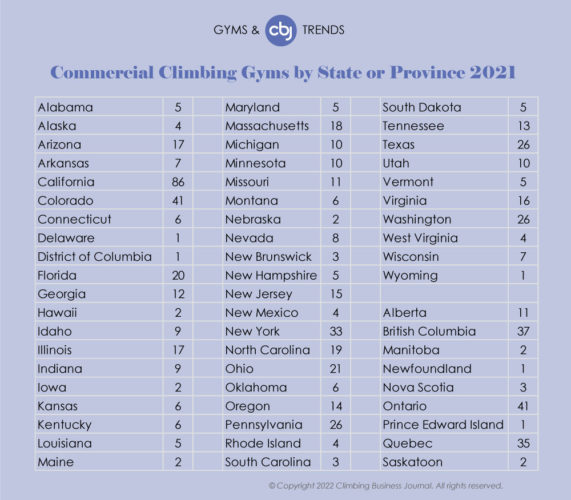
10 new climbing gyms opened in California in 2021
Breaking down the growth by state or province, California saw the most new climbing gym openings with 10, which was four more than the runner-up state, Washington (6). In fact, California set a new high point for the most new climbing gym openings in a state for a single calendar year, surpassing its own mark set in 2012 (7). Other states or provinces with more than two new gyms in 2021 were Colorado (4), Texas (4), New York (3), Ontario (3) and Pennsylvania (3). All these states/provinces except New York and Washington saw one permanent gym closure as well, and Pennsylvania was the sole state to lose multiple climbing gyms in 2021 when The Cave Climbing Gym in New Cumberland and the PRG in Coatesville closed their doors.
Not surprisingly given the climbing gym development in the state, California also welcomed the most new bouldering gyms last year—6, with Washington (5) and Texas (4) close behind. Once again the number was a high point, topping the previous record of new bouldering gyms to open in a state set by California in 2014 (5). In fact, California boasts the most total climbing gyms of any state or province with 86 currently in operation, ahead of Colorado and Ontario which each have 41.
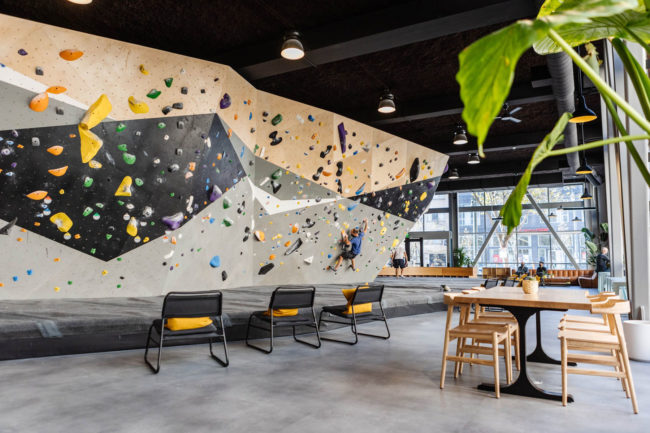
Much of the differences in climbing gym growth—as well as revenues—around the country, according to Danielson, is likely due in part to the ongoing impacts of the pandemic. “As we know even solely from looking at the story of California, Covid affected certain regions in radically different ways than others. So I can imagine that certain types of gyms may have had and will continue to have a harder time recovering.”
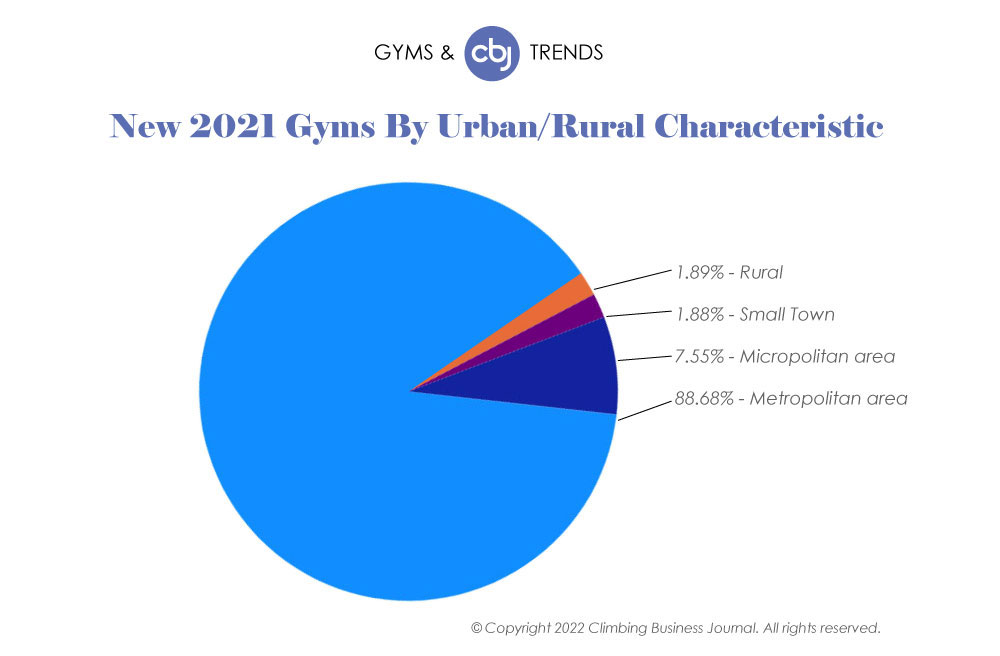
89 percent of new U.S. climbing gym openings in 2021 were in metropolitan areas
For the most part, regardless of the state, climbing gyms in the U.S. are located in zip codes characterized by USDA Economic Research Service data as metropolitan areas (92%). This trend largely continued in 2021, with 89% of new U.S. climbing gyms opening in metro areas from coast to coast. The greater New York City, San Francisco and Seattle areas all saw four new climbing gym openings, and new gyms also opened in other major metros like Chicago, Dallas, D.C., Denver, Detroit, Los Angeles, Philadelphia and Phoenix.
However, several climbing gyms have been popping up in less populated areas during particularly high growth years for the U.S. industry, and such was again the case in 2021. Six new climbing gyms were developed last year in micropolitan, small town or rural areas, the most since 2018 (8) and 2017 (7)―two years which recorded +50 new facilities as well. Climbing gyms that opened outside of metro areas in 2021 were High Altitude Fitness Truckee (CA), Salida Boulders (CO), Big Island Climbing (HI), Elev8 Climbing Gym (MI), Crag Climb Beavers Bend (OK) and Climb San Juan (WA).
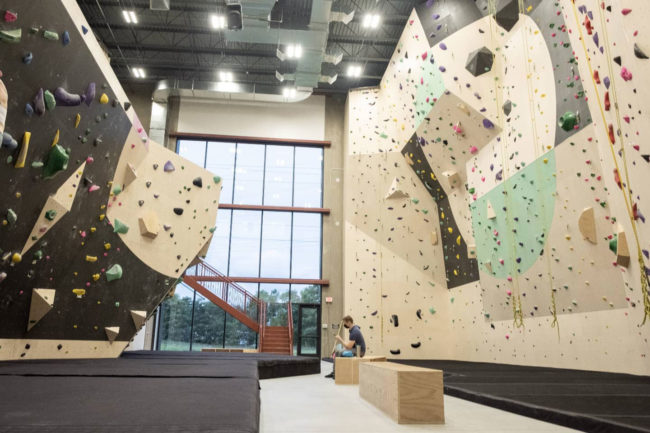
As climbing gym markets continue to develop, Fairfield expects competition to increase across the board, in both large metros and smaller cities, and feels that older facilities will likely need to upgrade and remodel or risk being “replaced” by newer incoming facilities. Fairfield also predicts that “climbing gyms with differentiated business models (bouldering, training, amenities, unique designs) will move in on generic, big box controlled markets,” and that “previously overlooked, seemingly fringe semi-rural and micropolitan markets will be pursued.”
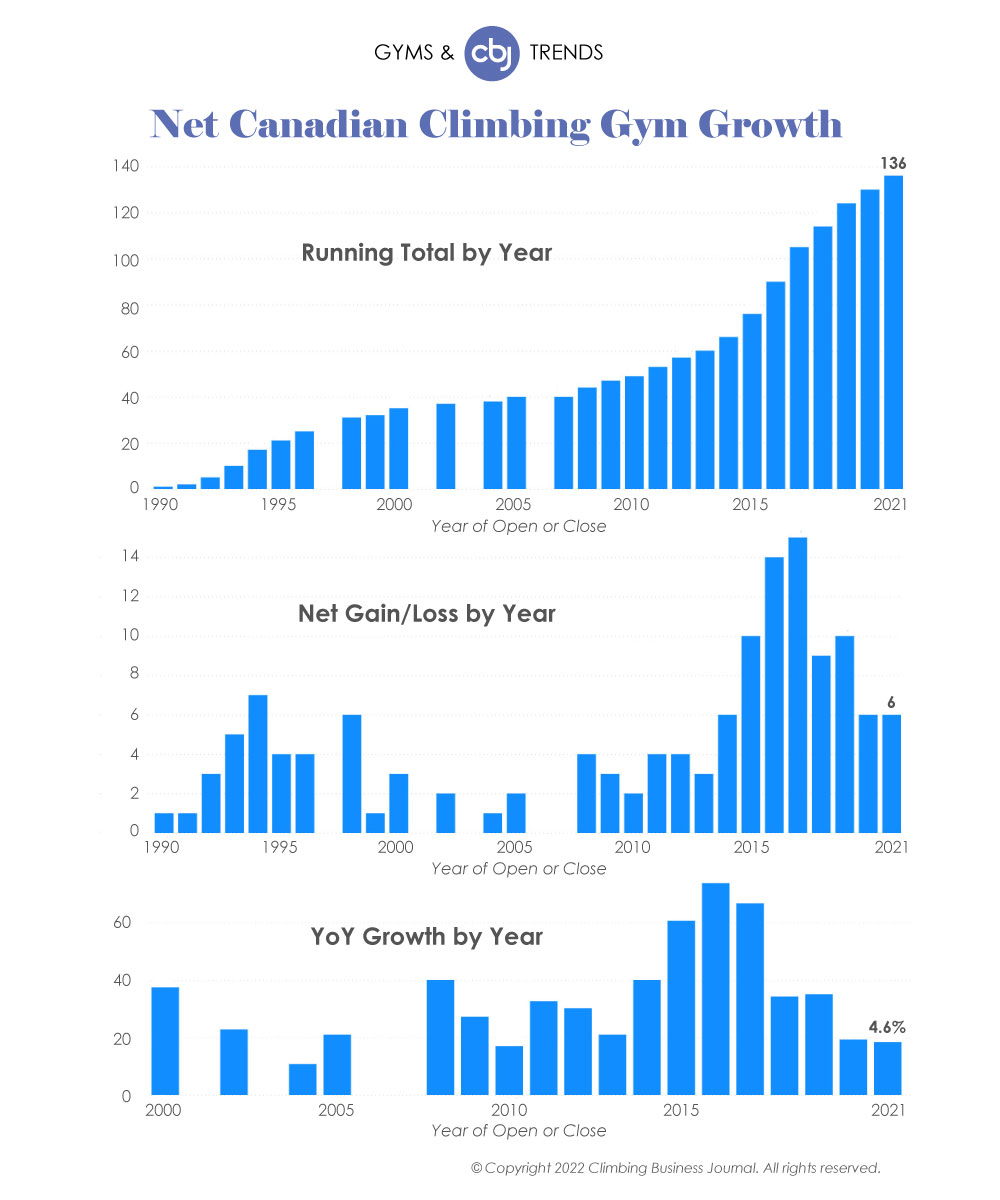
7 new climbing gyms opened in Canada in 2021
In contrast to the United States, Canada did not experience an increase in climbing gym growth in 2021. Quite the contrary, only seven new climbing gyms opened in Canada last year―the fewest since 2014 (6). On the flip side, only one climbing gym in the country permanently closed ―the Boiler Room, which only closed its 25-year-old facility in Kingston to open a new one nearby. But the growth rate of 4.62% was still the country’s lowest in over a decade.
Undoubtedly, the ongoing pandemic impacted the rate of climbing gym development in Canada’s provinces, which in general had longer forced closures than the U.S. Many facilities in Canada remained temporarily closed until last summer, with gyms in Toronto not reopening until July 16. When they did reopen, gyms in many provinces had to navigate required vaccination, with Quebec becoming the first province to introduce “vaccine passports” on September 1. Since then, almost every province has implemented vaccine requirements which apply to indoor gyms. (It’s worth noting that Ontario enacted another widespread lockdown of schools and gyms shortly before this report went to press, thus leaving the climbing gyms in that province once again temporarily closed.) Michelle Vanderheide, co-owner of Ontario’s Aspire gyms, admitted that the province’s lockdowns “continue to impact” business, and that mandatory proof of full vaccination “has been hard on the business.”
The staff at DÉLIRE say that the uncertainty of it all—something that many businesses can relate to in this global pandemic—remains a major factor, and there is a constant risk of temporarily losing “key employees” due to infections. Time will tell, but the heightened awareness of the happenings in one’s community, as a byproduct of the pandemic, could prompt people to seek out climbing gyms that are particularly and overtly community-minded. “The pandemic has shown people the importance of the community aspect, which seems to become decisive in people’s choices of activities and time investment,” DÉLIRE’s Jeff Beaulieu explained to CBJ. “This community effect being greater in a small gym, I think it will push some of the clientele towards these options.”
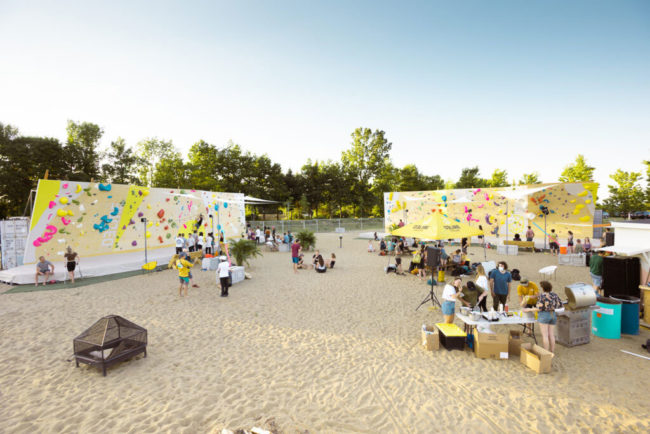
Despite the ongoing effects of the pandemic on all communities, climbing gym developers and manufacturers in Canada largely remain optimistic about the future and have continued pursuing new gym projects. Canada’s seven new climbing gyms in 2021 opened from coast to coast, and often as expansions by existing developers: BoulderHouse Langford in British Columbia (UPLIFY’s 7th location, the largest gym network in Canada); the outdoor DÉLIRE Parc in Quebec (DÉLIRE Escalade’s 4th location), Aspire Vaughan in Ontario (Aspire’s 3rd location). The Hive Climbing, as well, expanded its gym family to six locations when it acquired Cliffhanger in Vancouver, originally opened in 1993 and now known as The Hive Heights.
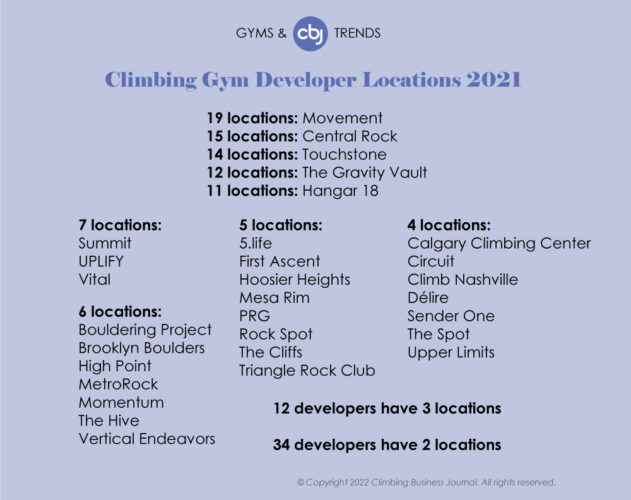
$1671 per thousand board feet was the cost of lumber in May
In June, CBJ reported that “in-store costs of virtually all components and raw materials increased greatly over the past year and are likely to continue trending upward.” This inflation impacted practically all elements of climbing gym construction in 2021, from wood and steel for climbing walls to foam for gym flooring and resin for holds production. The “bottom line” is that “prices are going up in the climbing industry,” said Kenny Matys, President of Atomik, in that article.
Since then, the prices of essential materials for climbing gym projects have continued to reach substantial levels, but sometimes with a great deal of volatility. Lumber, for instance, reached an all-time high closing price of $1,670.50 per thousand board feet in May before dropping to $454 in August―a roughly 75% decline―and rising back above $1,300 at the start of 2022. The price of foam, on the other hand, has been steadily on the rise according to flooring providers. “For Strati Climbing, foam has increased at least 4 times in the last 12 months, each increase compounding and resulting in the end product (a bouldering floor) costing approximately 25 to 30% more than in November 2019,” Ernest Coletta, owner of Strati Climbing, told CBJ.
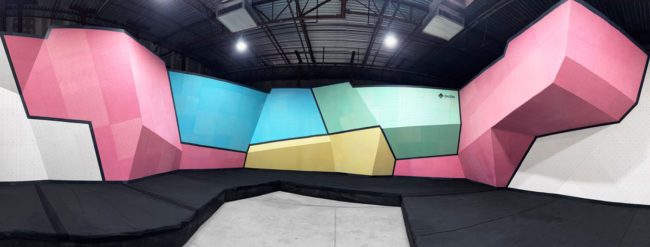
Coletta noted that the delays in manufacturing, particularly due to labor constraints, were thus far on the factory and raw material side rather than the installation side. But that does not mean the climbing industry is not challenged in matters of personnel. “The economics of labor is based on supply and demand, just like materials,” Dustin Buckthal explained. “When labor is in short supply relative to demand, prices tend to go up. Manufacturing and installing climbing walls, holds, and flooring are laborious undertakings, and labor shortages in conjunction with wage inflation have led to higher costs in our industry at large. We are continuing to invest in technology, continuous improvement, and R&D to combat these difficulties. This year, for example, we’ve added a robotic welding cell to fabricate top rope bars and much of the steel framework behind the walls. These advancements, among others, have partially offset increased costs for labor and materials.”
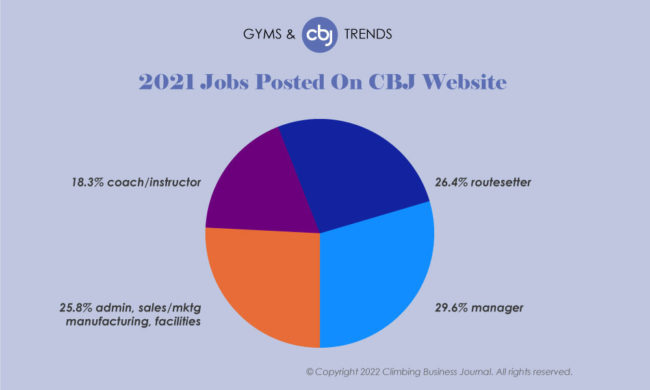
504 job listings were posted on the CBJ Job Board in 2021
An increased difficulty in hiring and retaining employees was an economic trend observed across industries in 2021. Dubbed “The Great Resignation,” the number of workers quitting their jobs reached record highs in 2021 according to a recent U.S. Bureau of Labor Statistics report and data. 4.5 million workers quit their jobs in the month of November alone, the most since the turn of the century. The accommodation and food service industries have been hit particularly hard, with nearly 1 million workers leaving their jobs that month. However, unemployment in November dropped to what was then the lowest rate since the start of the pandemic (4.2%), suggesting workers are typically leaving their jobs to take up another. As a result, the labor shortage has often been referred to as a quality jobs shortage, and The Great Resignation as The Great Reshuffle.
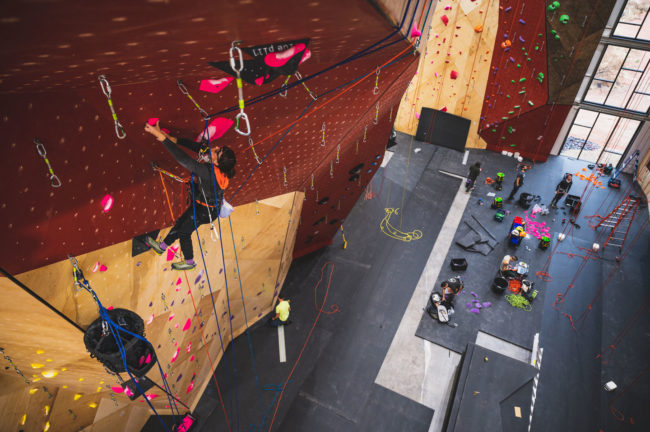
As with inflation, the climbing industry is not immune to these wider economic developments. Indeed, when crunching the numbers, more job listings were posted on the CBJ Job Board in 2021 (504) than any prior year. Jobs were listed in regions all throughout North America as well as worldwide, and most common were openings for managerial (30%), routesetting (26%) and coaching/instructor (18%) positions―often by gyms and brands filling multiple vacancies.
Danielson, who is himself a famed routesetter, told CBJ, “What I refer to as the professional class in climbing gyms―experienced routesetters, coaches, and high level gym managers―I’ve never seen the demand/supply ratio with that as challenging as it is for gyms today.”
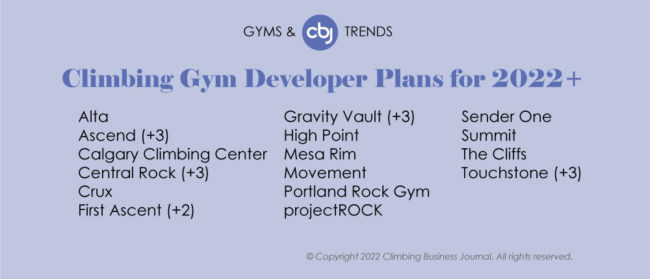
48 new climbing gyms are planned to open in North America in 2022+
Despite the challenges of the current economic climate, the climbing industry is poised for more robust gym growth in the coming years. Already 48 new climbing gym projects in North America are on our radar at CBJ at the turn of the calendar year―and more projects are always announced throughout the year. If all these gyms open this year, 2022 would mark the 10th consecutive year of +35 new climbing gym openings across the U.S. and Canada. About 40% of these facilities are slated to open across California (6), Pennsylvania (6) and Texas (6); Massachusetts (3), Arizona (2), New York (2), Ohio (2) and Quebec (2) are also expecting multiple new gyms. In addition to El Cap’s 20th location currently under construction, other top developers Central Rock, Touchstone and The Gravity Vault each have three new locations in the works, which would bring their respective gym totals to 18, 17 and 15―the most in North America. Pennsylvania-based ASCEND, as well, has plans for three new gyms, all in its home state.
As the climbing gym industry keeps moving forward in the pandemic age, Lucas Kovalcik, founder of The Gravity Vault gyms, predicts “the sport will continue to grow” in 2022 and new locations will “pop up in new and existing markets.” In fact, continued growth―despite the pandemic―was a prediction that we heard from many climbing gym owners and industry insiders in compiling this report. “We urge everyone to remain vigilant and move into this upcoming year with confidence,” Buckthal expressed to CBJ. “Climbing gyms are still a highly viable business venture, and we see no signs of the industry-wide upward trend slowing down.”
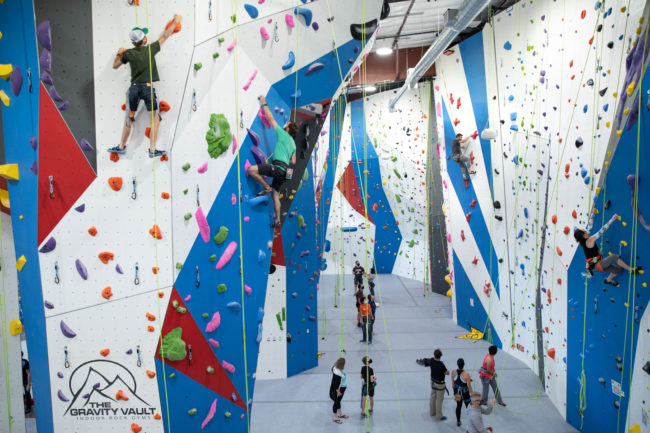
Fairfield pointed out that some climbing gym developers might cautiously wait to enact new gym projects until building and supply/manufacturing costs reconnect a bit. But, Fairfield stated, “they should not underestimate the numerousness, intentions and resolve of other often unknown rival facilities vying for the same markets.”
Françis Larose, CEO and co-founder of climbing gym designer OnSite, urged any would-be developer in 2022 to “make sure your project will be unique.”
And the staff at DÉLIRE encouraged developers to plan wisely for COVID mitigation and staff management costs, saying, “Climbing is a long-play game…you are likely not going to see a return on investment in the first year, especially with COVID around.”
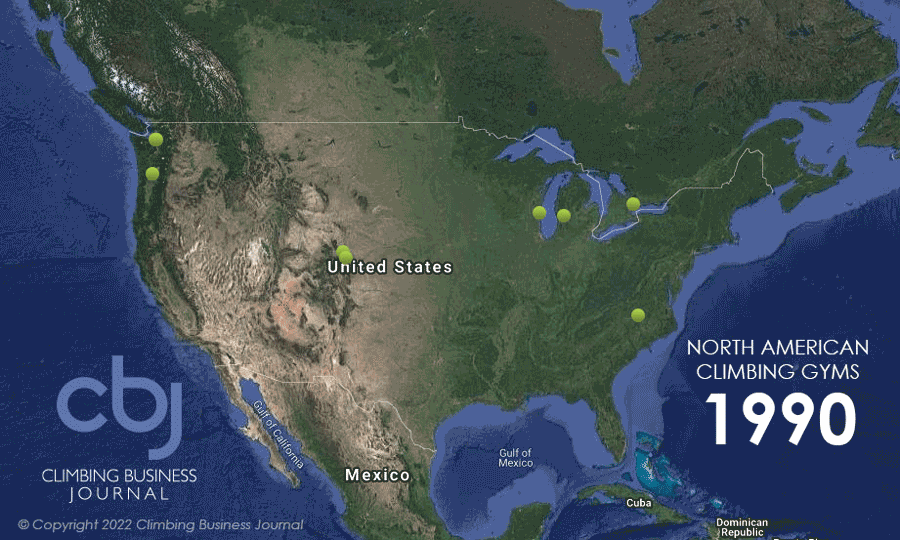
Behind the Data
CBJ is dedicated to researching and accurately reporting on climbing gym activity in the United States and Canada. We strive to always be data-driven. The industry growth rate and accompanying data were compiled through several different source avenues and are completely original and proprietary to CBJ. Any climbing gym is welcome—and encouraged—to update or add their information to CBJ’s comprehensive gym map and dataset here. For more information about the methodology behind the data, please visit the methodology section of Gyms & Trends 2019.
Thank you to everyone who has supported and furthered this research, including the researchers who devoted many hours to collecting and fact-checking the gym data and the industry insiders who contributed keen insights, observations and opinions on the industry activity of 2021. And thanks to the team who has long supported CBJ’s research, in particular CBJ publisher Scott Rennak, CBJ founders Mike Helt and Marlowe Kulley, map data guru Jon Lachelt, as well as John Burgman, Joe Robinson, Jamie Strong, Naomi Stevens and Madeleine Eichorn.

Climbing Business Journal is an independent news outlet dedicated to covering the indoor climbing industry. Here you will find the latest coverage of climbing industry news, gym developments, industry best practices, risk management, climbing competitions, youth coaching and routesetting. Have an article idea? CBJ loves to hear from readers like you!




